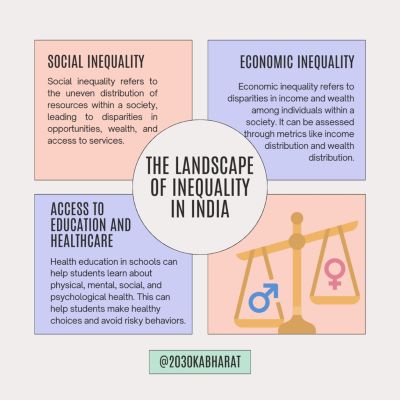Context
In the ongoing discourse surrounding economic inequality, the work of French economist Thomas Piketty has sparked significant debate, particularly in the context of India. Piketty, along with fellow economists, has presented findings suggesting a disturbing trend in India's economic landscape, indicating that inequality today surpasses that of the British colonial era. With the top 1% of the population commanding a disproportionate share of wealth and income, calls for wealth redistribution through measures like a wealth tax have gained traction.
The Economic Pie Has Grown
Examining the data presented by Piketty and his colleagues reveals nuanced trends in India's economic evolution. Contrary to assumptions, income and wealth inequality surged notably only from the 1980s, coinciding with India's gradual embrace of market principles. This period witnessed a dramatic decline in the share of national income held by the bottom 50%, alongside a significant rise in the share controlled by the top 10%. However, it's crucial to discern whether this decline in income share equates to a decline in real income or living standards for the bottom strata of society.
Contrary to initial impressions, analysis from the World Inequality Lab suggests that despite the diminishing slice of the income pie, the bottom 50% have experienced a substantial increase in real income over the past three decades. This suggests a substantial expansion of India's economic pie, resulting in improved living standards for many despite a lower share of national income. However, disparities persist, highlighting the limited economic freedom experienced by the bottom 50%, inhibiting their ability to compete on equal footing in the market.
Barriers to Economic Freedom
The stark income differentials observed in India underscore structural impediments that hinder equitable participation in the market. While theoretically, a free market would incentivize individuals to pursue lucrative opportunities, the reality is far more complex. Barriers such as limited access to capital and prohibitive costs of education thwart the mobility of individuals from lower-income brackets, perpetuating inequality. In this scenario, the solution lies not in imposing heavier taxes on high-income earners but in dismantling barriers that restrict the economic agency of the marginalized.
Liberalizing sectors such as finance and education presents a viable pathway towards fostering economic mobility. By facilitating access to capital and reducing barriers to skill acquisition, marginalized communities can engage more effectively in high-paying sectors, narrowing the income gap organically. However, the efficacy of such measures hinges on addressing fundamental issues such as property rights, which are disproportionately skewed against the disadvantaged. Thus, enhancing economic freedom for India's poor emerges as a prerequisite for fostering inclusive growth.
Wealth Inequality is Inevitable
The dynamics of wealth distribution in India reveal a similar narrative of entrenched disparity. While wealth inequality is an inherent feature of market economies, the extreme concentration of wealth in India reflects systemic distortions rather than market efficiencies. The prevalence of special privileges afforded to the elite exacerbates wealth disparities, shielding them from competitive forces that would naturally erode their dominance. Consequently, dismantling these entrenched privileges represents a critical step towards mitigating wealth inequality and fostering a more equitable economic landscape.
The notion of a wealth tax as a panacea for addressing inequality warrants scrutiny, given its potential ramifications. Contrary to popular belief, such measures risk unintended consequences, ultimately exacerbating the plight of vulnerable segments of society. By diminishing investor returns, wealth taxes inadvertently suppress job creation and wage growth, disproportionately impacting lower-income groups. Moreover, the bulk of wealth held by the affluent comprises productive assets vital for driving economic output, challenging the notion that their wealth accumulation stifles living standards for others.
Impact of a Wealth Tax
Delving deeper into the implications of a wealth tax unveils its adverse effects on economic growth and social welfare. By disincentivizing investment and entrepreneurship, such measures impede innovation and productivity, stifling the engine of economic progress. Moreover, the burden of wealth taxes disproportionately falls on labor and landowners, exacerbating income disparities and hindering upward mobility. Rather than fostering a more equitable distribution of wealth, wealth taxes risk entrenching existing disparities, undermining the very objectives they seek to address.
The narrative surrounding wealth taxation necessitates a paradigm shift towards prioritizing economic freedom over punitive measures targeting the affluent. By empowering marginalized communities to actively participate in the market, policymakers can cultivate a more inclusive economic ecosystem conducive to sustained growth. However, achieving this vision demands comprehensive reforms aimed at dismantling systemic barriers and fostering an environment where every individual has the opportunity to thrive.
Conclusion
The discourse on economic inequality in India underscores the complex interplay of factors shaping the distribution of wealth and income. While calls for wealth redistribution through measures like a wealth tax may seem appealing on the surface, a deeper analysis reveals the inherent limitations and unintended consequences of such approaches. Instead, the focus should be on enhancing economic freedom for marginalized communities, thereby enabling them to compete on equal footing in the marketplace.
Addressing entrenched disparities requires a multifaceted approach that encompasses structural reforms aimed at dismantling barriers to mobility and fostering inclusive growth. By prioritizing economic empowerment over punitive measures, policymakers can lay the groundwork for a more equitable and prosperous future for all segments of society. Ultimately, the path to combating inequality lies not in penalizing the affluent but in empowering the marginalized to realize their full potential in a dynamic and inclusive economy.
|
Probable Questions for UPSC Mains Exam
|
Source – The Hindu







